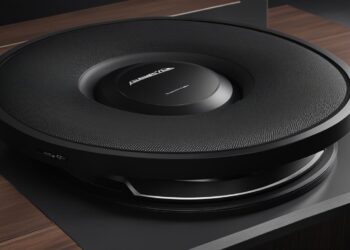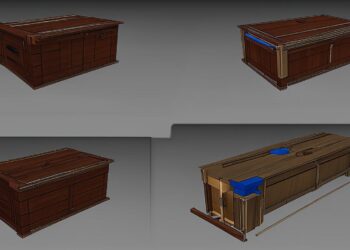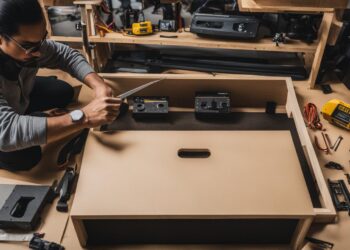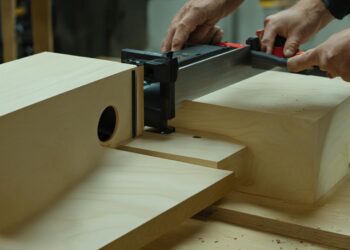Are you ready to take your sound system to the next level? Imagine the deep, powerful bass that can transform your music, movies, and gaming experiences. But how can you achieve that kind of audio quality? The answer lies in building your own 15 inch subwoofer enclosure.
A custom subwoofer enclosure is a game-changer when it comes to enhancing your sound experience. And the best part? You can build it yourself with the right guidance. In this comprehensive guide, I will walk you through the step-by-step process of building your very own 15 inch subwoofer enclosure. From the design and materials to the construction and finishing touches, you’ll learn everything you need to know to create a premium subwoofer enclosure that will elevate your sound system to new heights.
Building a 15 inch subwoofer enclosure may seem daunting at first, but with the right instructions and a little bit of patience, you’ll be amazed at what you can accomplish. Whether you’re a seasoned DIY enthusiast or just starting out, this guide will provide you with all the knowledge and guidance you need to build a subwoofer enclosure that perfectly complements your subwoofer and delivers exceptional bass performance.
Key Takeaways:
- Building a custom subwoofer enclosure can greatly enhance your sound experience.
- By following the step-by-step instructions, you can easily create a premium subwoofer enclosure.
- Choosing the right design and size is crucial for optimizing the performance of your subwoofer.
- Gathering the necessary materials and tools is essential before starting the construction process.
- Finishing touches and proper installation are important for achieving the best sound quality.
Choosing the Right Design and Size for Your Subwoofer Enclosure
When it comes to building a subwoofer enclosure, the design and size play a crucial role in achieving optimal sound quality. The right enclosure design and dimensions can make a significant difference in the performance of your subwoofer. Here are some essential tips to consider when choosing the design and size for your subwoofer enclosure.
1. Manufacturer’s Recommendations
Start by reviewing the manufacturer’s recommendations for your specific subwoofer. They often provide guidelines for the ideal enclosure size and type that will complement the subwoofer’s performance. Adhering to these recommendations will ensure that you achieve the best possible sound output.
2. Subwoofer Box Plans
If you prefer a DIY approach, you can find numerous subwoofer box plans online. These plans provide detailed instructions on building enclosures for different subwoofer sizes and types. Look for plans that are specifically designed for 15-inch subwoofers to ensure the best fit and performance.
3. Designing Your Own
If you have advanced knowledge of subwoofer enclosure design, you can create your own plans based on the specifications of your subwoofer. Consider factors such as the subwoofer’s Thiele-Small parameters, which include parameters like Vas, Qts, and Fs. These parameters help determine the optimal internal volume, port dimensions, and enclosure type for your subwoofer.
4. Dimensions and Internal Volume
Pay close attention to the dimensions and internal volume of the subwoofer enclosure. The dimensions should provide enough space to accommodate the subwoofer while ensuring proper airflow. The internal volume should match the manufacturer’s recommendations or the specifications derived from your own design to obtain the desired bass response and overall sound quality.
Remember, the design and size of your subwoofer enclosure directly impact its performance. Taking the time to choose the right design and dimensions will help you maximize the potential of your subwoofer and create an immersive audio experience.
| Enclosure Design Tips | Subwoofer Box Dimensions | 15 Inch Subwoofer Box Plans |
|---|---|---|
| Consider manufacturer’s recommendations | Ensure proper dimensions and internal volume | Find online plans or design your own |
| Account for subwoofer specifications | Create plans based on subwoofer type | Follow instructions for 15-inch subwoofers |
| Optimize airflow and bass response | Match internal volume to recommendations | Customize dimensions for optimal performance |
Choosing the right design and size for your subwoofer enclosure is a critical step in achieving exceptional sound quality. By considering the manufacturer’s recommendations, using subwoofer box plans, or designing your own, you can create an enclosure that optimizes performance and enhances your audio experience.
Gathering the Necessary Materials and Tools
Before you begin building your subwoofer enclosure, it’s essential to gather all the necessary materials and tools. Having everything on hand will ensure a smooth and efficient construction process. Here are the key materials you’ll need:
- Medium Density Fiberboard (MDF): This is the main material for constructing the enclosure. MDF is a dense and versatile wood composite that is ideal for subwoofer enclosures due to its excellent acoustic properties.
- Screws and Glue: These are used to securely fasten the MDF panels together. It’s important to use high-quality screws and strong adhesive glue to ensure the structural integrity of the enclosure.
- Caulk: Caulk is used to seal any gaps or joints in the enclosure to prevent air leaks. This ensures optimal performance and prevents unwanted vibrations.
- Upholstery Adhesive: If you plan on carpeting the enclosure or adding any other finishing touches, upholstery adhesive will be necessary to securely attach the materials.
In addition to the materials, you’ll also need a set of essential tools to facilitate the construction process. Here are the tools you should have:
- Jigsaw: A jigsaw is used for cutting the MDF panels to the proper dimensions and creating any necessary openings or curves.
- Table Saw or Circular Saw: A table saw or circular saw will make it easier to cut the MDF panels with precision and accuracy.
- Electric Drill: An electric drill will be required for drilling holes and attaching screws during the assembly process.
- Various Drill Bits: Different drill bits will be needed depending on the size of the holes required for mounting the subwoofer and other components.
With these materials and tools in hand, you’ll be well-prepared to embark on the construction of your subwoofer enclosure. The next section will take you through the step-by-step process of building the enclosure, ensuring a successful outcome.
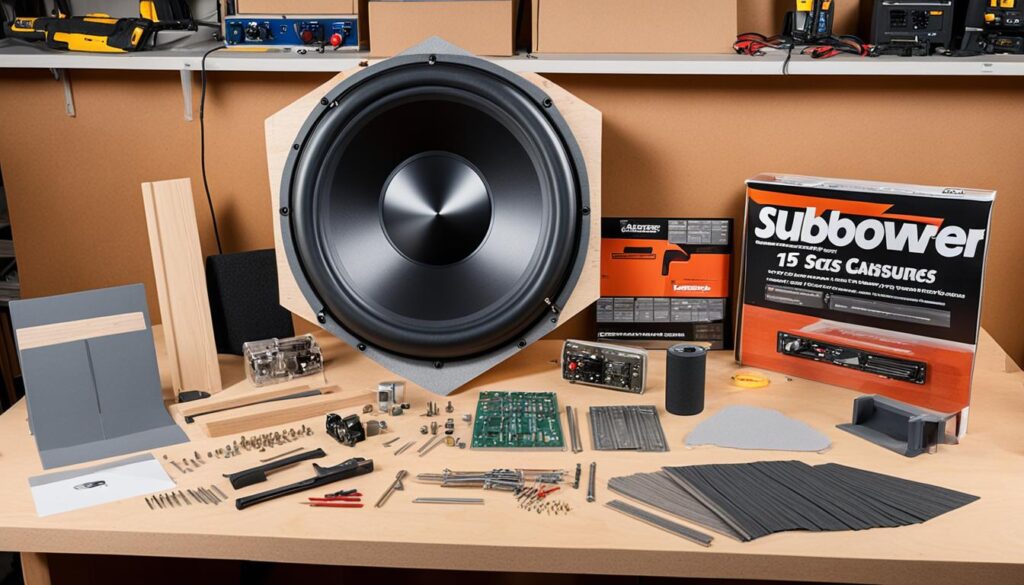
Step-by-Step Construction Process
Building a subwoofer enclosure requires a step-by-step approach to ensure a successful construction. Follow these instructions carefully to create a high-quality enclosure for your subwoofer.
- Gather the necessary materials: Before you begin, make sure you have all the materials and tools required for the construction. These include MDF panels, screws, glue, a jigsaw, an electric drill, and various drill bits.
- Cut the MDF panels: Start by cutting the MDF panels to the proper dimensions. Measure and mark the dimensions based on the design and size of your subwoofer enclosure, then use a jigsaw or circular saw to make the cuts.
- Assemble the panels: Once the panels are cut, assemble them using screws and glue. Apply adhesive to the edges of the panels, align them properly, and secure them together with screws. Ensure that the panels are tightly connected to create a solid structure.
- Create openings: Next, create openings in the enclosure for the subwoofer and terminal cup. Measure the dimensions of these components and mark the locations on the panels. Use a jigsaw or a hole saw to carefully cut out the openings.
- Seal the enclosure: To prevent any air leaks, it’s important to seal the enclosure properly. Apply caulk along the seams and edges of the enclosure to ensure a tight seal. This will help optimize the performance of your subwoofer.
- Take your time: During the construction process, it’s crucial to take your time and pay attention to detail. Carefully follow the instructions and double-check your measurements to ensure a precise and accurate construction. Rushing through the process may result in a subpar enclosure.
By following these step-by-step instructions, you can construct a subwoofer enclosure that not only fits your subwoofer perfectly but also delivers optimal sound performance. Take pride in your workmanship and enjoy the impressive bass reproduction provided by your custom-built enclosure.
Finishing Touches and Installation
Now that the construction of your subwoofer enclosure is complete, it’s time to add the final touches and install it in your sound system setup. This section will provide you with essential tips and techniques for achieving a professional finish and ensuring a seamless installation process.
Subwoofer Enclosure Finishing Tips
One of the crucial steps in completing your subwoofer enclosure is choosing the right finish. This not only enhances its appearance but also protects the wood from moisture and scratches. You have two popular options: carpeting and painting.
Carpeting: Carpeting your subwoofer enclosure gives it a clean and professional look. It also helps to dampen vibrations and reduce resonances. To carpet your enclosure, follow these steps:
- Cut the carpet to fit the dimensions of your enclosure.
- Protect the painted areas with tape to prevent adhesive from sticking.
- Apply upholstery adhesive to the enclosure’s surface.
- Carefully wrap the enclosure with the carpet, smoothing out any wrinkles or bubbles.
- Secure the carpet with staples or glue.
Painting: Painting your subwoofer enclosure allows for customization and creativity. You can match it to your car’s interior or create a unique visual design. Consider these tips when painting your enclosure:
- Sand the enclosure’s surface to create a smooth, paint-friendly texture.
- Apply a primer coat to enhance the adhesion of the paint.
- Choose a high-quality paint that is durable and suitable for wood surfaces.
- Apply multiple thin coats of paint, allowing each coat to dry completely.
- Consider adding a clear coat for added protection and a glossy finish.
Installation Process
With your subwoofer enclosure finished, it’s time to install it properly in your sound system. Follow these steps to ensure a smooth installation:
- Place the enclosure in the desired location, ensuring it fits securely and does not interfere with other components.
- Connect the necessary wiring, including power and audio cables, to the subwoofer and your amplifier.
- Make sure all connections are secure and free from any potential hazards or interference.
- Double-check the polarity of the speaker wires to ensure proper phase alignment.
- Test the subwoofer to ensure it is functioning correctly and producing the desired bass response.
Once you have completed the finishing touches and properly installed your subwoofer enclosure, you can sit back, relax, and enjoy the immersive and powerful bass that it adds to your sound system.
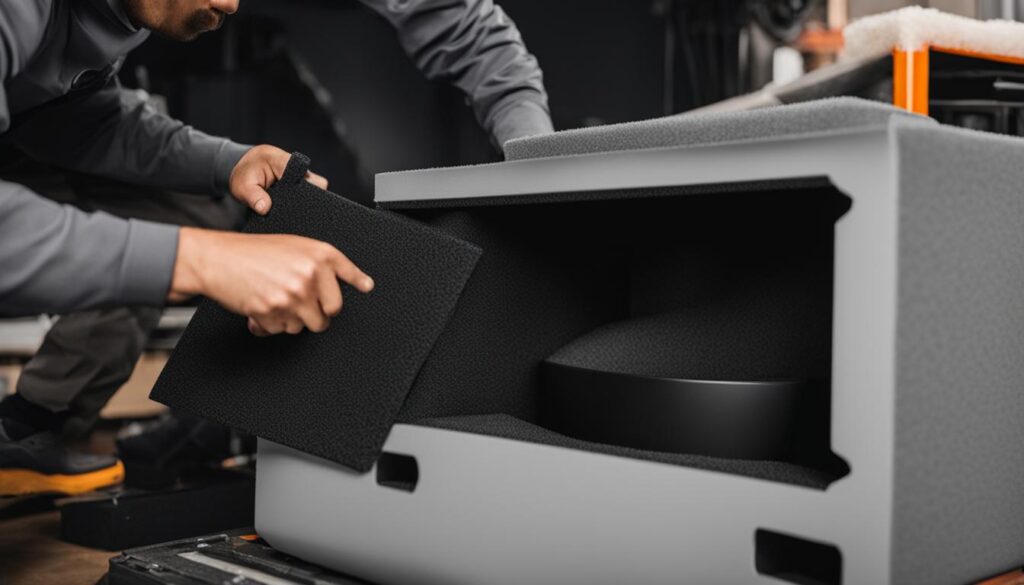
| Pros of Carpeting | Pros of Painting |
|---|---|
| Provides a clean and professional look | Allows for customization and creativity |
| Dampens vibrations and reduces resonances | Can match the car’s interior or create a unique design |
| Protects the wood from moisture and scratches | Can enhance the appearance of the enclosure |
Optimizing Performance and Enjoying the Results
After you have built and installed your subwoofer enclosure, it’s time to optimize its performance to achieve the best sound quality possible. Tuning your subwoofer box and adjusting your amplifier settings are essential steps in achieving the desired bass response and overall sound experience. By experimenting with different settings and placement options, you can fine-tune your subwoofer to deliver powerful and accurate bass reproduction.
When it comes to subwoofer box optimization, there are a few key factors to consider. First, make sure the enclosure is properly sealed to prevent any air leaks that can affect the sound quality. Check for any gaps or loose connections and use caulk or similar materials to seal them. Additionally, ensure that the subwoofer is securely mounted in the enclosure, allowing it to vibrate freely without any rattling or unwanted vibrations.
Next, focus on tuning your subwoofer box to achieve the desired bass response. This involves finding the right balance between the subwoofer’s volume, amplifier settings, and crossover frequency. Adjust the volume level on your amplifier to match the output of your subwoofer. If the bass sounds too overpowering and boomy, decrease the volume. Conversely, if the bass feels weak or lacking impact, increase the volume.
Additionally, adjust the crossover frequency on your amplifier to determine the range at which your subwoofer reproduces sound. Higher crossover frequencies will result in a more defined and focused bass, while lower frequencies will produce a deeper and more resonant bass. Experiment with different crossover settings to find the optimal balance for your specific subwoofer and listening preferences.
It’s also important to consider the placement of your subwoofer box in your car or home theater setup. Different locations within your vehicle or room can have a significant impact on the bass response. Placing the subwoofer in a corner or near a wall can enhance the bass output by utilizing the room’s acoustics. However, avoid placing the subwoofer too close to a wall, as this can cause excessive vibrations or boomy bass. Experiment with different placements to find the sweet spot that delivers the best bass response for your setup.
With proper subwoofer box optimization and tuning, you can enjoy a superior sound experience with deep, impactful bass that enhances the overall audio performance. Take the time to fine-tune your subwoofer, experiment with different settings, and find the perfect placement to achieve the optimal sound quality that matches your preferences.
Conclusion
Building a 15-inch subwoofer enclosure through DIY construction is a rewarding endeavor that can greatly enhance the performance of your sound system. By carefully following the step-by-step instructions, selecting the appropriate design, acquiring the necessary materials, and constructing the enclosure with meticulous attention, you can create a custom enclosure that perfectly complements your subwoofer and elevates your overall listening experience.
A professionally built subwoofer enclosure ensures the delivery of deep, impactful bass and improved sound quality. When properly sealed and tuned, it optimizes the performance of your subwoofer, allowing it to produce powerful and accurate bass reproduction. The precise design and construction of the enclosure help to minimize air leaks, contributing to a tighter and more defined bass response.
Enjoy the rewards of your labor and craftsmanship as you immerse yourself in the rich audio experience provided by your well-built subwoofer enclosure. Feel the vibrations and depth of the bass as it resonates throughout the room, adding a new dimension to your music, movies, and gaming. Recognize the meticulous construction as it integrates seamlessly into your sound system, enhancing both its functionality and aesthetics.
In conclusion, embarking on the construction of a 15-inch subwoofer enclosure allows you to personalize your sound system and unlock its full potential. Follow the recommended guidelines, exercise patience and attention to detail, and savor the final outcome—an outstanding subwoofer enclosure that takes your audio experience to new heights.
FAQ
How do I choose the right design and size for my subwoofer enclosure?
Consider the manufacturer’s recommendations for enclosure size and type. You can find subwoofer box plans online or design your own based on the specifications of your subwoofer. Pay attention to dimensions and internal volume for optimal performance.
What materials and tools do I need to build a subwoofer enclosure?
You will need medium density fiberboard (MDF) for the main structure, along with screws, glue, caulk, and upholstery adhesive for finishing touches. Tools such as a jigsaw, table saw or circular saw, electric drill, and various drill bits will be required for cutting and assembling the enclosure.
What is the step-by-step construction process for a subwoofer enclosure?
The process involves cutting MDF panels to the proper dimensions, assembling the panels with screws and glue, and creating openings for the subwoofer and terminal cup. The enclosure must be properly sealed to prevent air leaks.
How do I add finishing touches to my subwoofer enclosure?
Finishing touches can include painting the enclosure, carpeting it for a clean look, and adding aesthetic elements such as metal mesh or trim. Protect painted areas with tape before applying upholstery adhesive and wrapping the enclosure in carpet.
How do I optimize the performance of my subwoofer enclosure?
Optimization involves tuning the enclosure for desired bass response and adjusting your amplifier’s settings. Experiment with different settings and placement options to find the best sound quality for your preferences.
What are the benefits of building a custom subwoofer enclosure?
A custom enclosure allows you to perfectly match your subwoofer and enhance your sound system’s performance. It provides powerful and accurate bass reproduction, elevating your overall sound experience.






